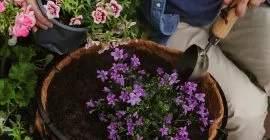We all love the summer with high temperatures and glorious sunshine. However, it is important to think about the plants in this weather and even though we all think sunshine is great for them, too much can cause damage and they need to be protected.
Here are some top tips which we have put together for you to protect your plants this summer.
1. Watering
As the temperatures are rising the demand for water from a plant also rises. Therefore, it is pretty obvious to say that you must water your plants on a regular basis. It is best to water in the coolest part of the day which is usually early morning, evening or both. It is hard to say how often plants should actually be watered, because it depends on the exact temperature, but usually a good watering 3 times a week will keep them hydrated. To know when to water, feel the soil; if it feels moist, there is no need to water.
A common problem when caring for plants in the summer is to over-water them. This is just as bad for plants as under-watering because too much water can lead to root diseases. When your plant looks like it is wilting, it is assumed that it needs to be watered. However, ensure you feel the soil for moisture before watering, because in many cases it will not need water. The reason for wilting is simply a way of it protecting itself in excessive heat, by releasing moisture. When the sun goes in, the leaves should soon come back into shape.
2. Mulching
Mulching can help to improve soil around plants by helping it to retain moisture in it. This is very important in summer for when moisture is limited. A good mulch is Gro-Sure Smart Ground Cover.
3. Shade
Even though some sunshine is great for the plants, too much can lead to scorching and stop the plants from flowering. If temperatures go above 32°C, the plants need to be protected from direct sunlight. You should give your plants shade during the hottest part of the day. For example you can use a patio umbrella or if in pots, place in a shaded part of your garden. Shade cloths and row covers can also be used.
4. Protect from the wind
If the weather is windy, even though it may feel cooler, it dehydrates the plants more quickly. This is because wind dries out the soil. Ensure you continue to water plants and check the moisture of the soil. In these conditions, heavy warm winds can damage the plants too and to prevent this you can build a wind break or grow climbers on flat trellises that act as a wind break. Alternatively, protect delicate and smaller plants with bigger, sturdier plants by planting them next to each other. This can also be an effective way of providing shade to smaller plants.




